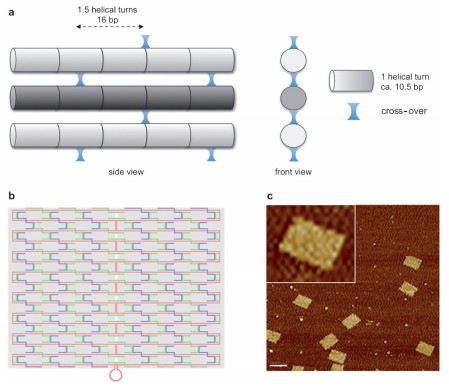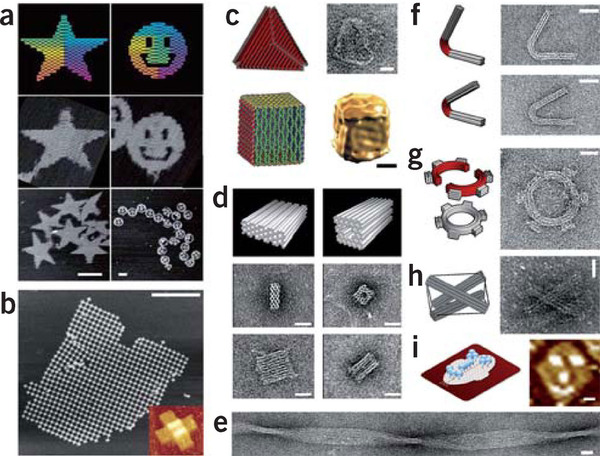Difference between revisions of "DNA Origami"
| Line 6: | Line 6: | ||
[[File:DNA_origami_figure1.jpg]] | [[File:DNA_origami_figure1.jpg]] | ||
| + | |||
| + | The same design principle can also be used to generate three-dimensional structures. To this end, an origami structure is assembled which contains individual 2D sheets. Those sheets are connected at specific angles by an additional set of cross-overs between interfacing helices at the edges. This generates 3D objects with an internal cavity. | ||
| + | |||
| + | [[File:DNA_origami_figure2.jpg]] | ||
| + | |||
| + | ==Multilayer-Layer DNA Origami== | ||
| + | |||
| + | One major limitation of single-layer DNA-origami structures is their relatively weak resistance to mechanical stress. To address this problem, more rigid 3D DNA objects have been developed by either packing multiple helices into a space-filling structure or taking advantage of tensegrity rules. Multilayer DNA-origami structures are densely packed arrays of antiparallel helices interconnected through a defined 3D arrangement of cross-overs. The register of such cross-overs, that is their relative angular displacement with respect to the axis of the helix, defines the way adjacent helices are interconnected and, therefore, determines the geometry of the basic building blocks. | ||
==Applications of DNA Origami== | ==Applications of DNA Origami== | ||
Revision as of 00:13, 25 January 2012
In 1982 Seeman proposed using DNA as a construction material for the assembly of geometrically defined objects with nanoscale features. DNA-origami technique folds a long single-stranded DNA strand (scaffold) into a desired shape with the help of hundreds of short oligonucleotides, called staple strands.
Contents
Single-Layer DNA Origami
In the original study of Rothemund,6 several planar origami structures were produced, ranging from simple rectangular shapes to more complex forms, such as stars, triangles, as well as nongeometric figures such as smiley faces. These objects were generated by following a common design rule: every helix within the structure is connected to two neighboring helices by a regular pattern of cross-overs interspaced by 1.5 helical turns, which for a B-type DNA corresponds to about 16 base pairs (Figure 1). This register of cross-overs generates interhelical connections every 180°, thus leading to a single layer of helices arranged into a planar sheet.
The same design principle can also be used to generate three-dimensional structures. To this end, an origami structure is assembled which contains individual 2D sheets. Those sheets are connected at specific angles by an additional set of cross-overs between interfacing helices at the edges. This generates 3D objects with an internal cavity.
Multilayer-Layer DNA Origami
One major limitation of single-layer DNA-origami structures is their relatively weak resistance to mechanical stress. To address this problem, more rigid 3D DNA objects have been developed by either packing multiple helices into a space-filling structure or taking advantage of tensegrity rules. Multilayer DNA-origami structures are densely packed arrays of antiparallel helices interconnected through a defined 3D arrangement of cross-overs. The register of such cross-overs, that is their relative angular displacement with respect to the axis of the helix, defines the way adjacent helices are interconnected and, therefore, determines the geometry of the basic building blocks.
Applications of DNA Origami
DNA-origami structures could be used as molecular pegboards for arranging arbitrary objects of interest with nanometer precision. Interactions and/or transformation of the arrayed objects, such as nucleic acids, small-molecules, proteins, or nanoparticles, can be analyzed by single-molecule techniques, although, in some cases, even bulk measurements can be carried out.
References
1. Chenxiang Lin, Yan Liu Dr., Sherri Rinker, Hao Yan Prof. Dr. DNA Tile Based Self-Assembly: Building Complex Nanoarchitectures
2. Dr. Barbara Saccà*, Prof. Dr. Christof M. Niemeyer* DNA Origami: The Art of Folding DNA

